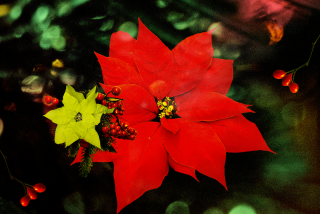Poinsettias Outlast the Holidays
- Share via
Poinsettias have become symbols of the holiday season and popular household decorations because of their bright colors.
Unfortunately, many people regard them as temporary holiday decor and discard them along with the Christmas tree once the new year arrives.
But the many new varieties of poinsettias (Euphorbia pulcherrima) now available have been hybridized to produce long-lasting color. With proper care and good attention, poinsettias can remain in bloom until spring. And the plant can endure for many years.
The secret to success with poinsettias is to provide just the right amount of water and light.
“Most people either drown them with water or don’t water them enough,” said Jack Williams, a grower at Paul Ecke Ranch in Encinitas, the nation’s largest poinsettia grower.
“Poinsettias are not particularly difficult to maintain, and can last for years, with careful attention,” he added.”
Poinsettias respond quickly to adverse conditions by developing yellow leaves and then dropping them. But leaf drop doesn’t mean that the plant is dead or dying. Before assuming that the problem is lack of water, test the soil by inserting a finger one inch deep. Water the plant only if the soil is dry one inch below the soil line.
During the holiday season, most poinsettia plants are packaged in colorful foil wrappings. When watering the plant, it’s crucial to remove it from the foil or decorative container so the water can drain through completely.
This plant hates to have its feet wet, and is highly susceptible to root rot. Avoid this by making sure the plant doesn’t stand in water when it’s replaced in its container. Poking holes in the foil wrapping and watering the plant in its covering won’t solve the problem since most people put a saucer or similar device under the plant to catch the dripping water.
Another reason for yellow leaves is when the plant receives insufficient light. The ideal location is where they can receive at least six hours of bright, indirect light daily. Avoid direct light, however. Keep poinsettias away from drafts, radiators and hot-air registers.
Poinsettias require regularly feeding to thrive. Because the growers have supplied them with a regular fertilizing program while they were developing in greenhouses prior to sale, the plants will have enough fertilizer in their soil to last them through the holiday season.
Poinsettias can remain as indoor houseplants or be transported outdoors when all danger of frost is past, usually in March or April, depending on the garden location.
If the poinsettia is to be planted in a garden, choose a site that provides bright light, but that’s protected from hot, direct sunlight. The plant’s color is from the bracts, rather than its flowers (poinsettias, like other euphorbias produce very small, nondescript flowers). But poinsettias require long periods of darkness for the bracts to develop their characteristic color.
September through December, poinsettias require more hours of dark than of light. Nature provides this with long, dark nights, but the natural balance of light and dark can be interrupted if the plant is in a spot where inside lights or outdoor spotlights or street lights shine on it. If this happens, it will be necessary to cover the plant each night until the bract coloration forms.
Poinsettias require good, loose well-draining soil that’s neutral or slightly acid.
After selecting the garden site and preparing the soil, cut the potted plant back to about six inches above the soil line. This should result in several leaves left on each branch, and will help the plant stay short and bushy. When planting, be sure to place the plant at the same soil level it was in the pot.
Williams said that because of the changes hybridizers have made in poinsettias, the newer varieties do better kept in pots outdoors.
When new growth appears, the plant should be transplanted to a larger container. Pot up one size larger. Use any good-quality commercial potting soil mix and water well. Check the plant for water requirements in a similar manner as if it were indoors.
In addition to root rot, poinsettias are susceptible to white fly infestation. If this happens, spray the plant thoroughly with an insecticidal soap preparation, available at local nurseries.
While the standard three- to six-bloom, red poinsettia is the most frequently used decoration, other sizes, shapes and colors are also available.
Colors can range from creamy white through shades of pink and orange. Some have marbled bracts of pink and white or pink flecks on red. Sizes range from miniature to trees and hanging baskets.
For many people, enjoyment of poinsettias has been marred by the plant’s notorious reputation as being deadly to children and pets. But the plant has been given a clean bill of health as a result of research conducted at Ohio State University.






